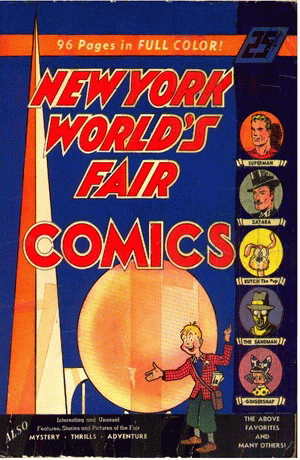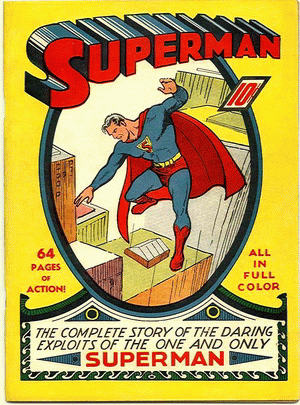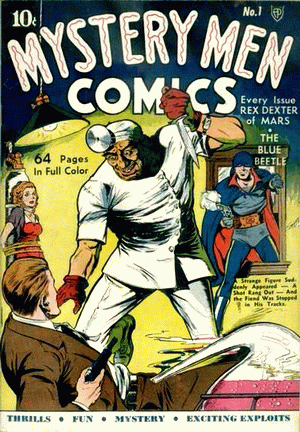Newsstand Period 1922 - 1955
 New York’s World’s Fair #1
came out in April of 1939. It was to
be sold at the World’s Fair only. It was 100 pages thick with
cardboard covers. It cost 25 cents, but didn’t sell because all other comics
were 10 cents. By the late summer they would be re-priced to 15 cents.
This comic would show a blond Superman and would be the first
appearance of a gas mask wearing hero named The Sandman.
A 2nd
issue came out a year later showing Superman, Batman and Robin together
on the cover. From this title sprung
Worlds Best Comics (1 issue)
then it was renamed
Worlds Finest Comics with the 2nd
issue. The selling point of these titles would be reading both Superman and Batman in one
comic. Within the comic they were in separate stories until
issue #71.
Due to a reduction of story pages they decided to put them together in
the same story. The series would go 323 issues ending in 1986.
New York’s World’s Fair #1
came out in April of 1939. It was to
be sold at the World’s Fair only. It was 100 pages thick with
cardboard covers. It cost 25 cents, but didn’t sell because all other comics
were 10 cents. By the late summer they would be re-priced to 15 cents.
This comic would show a blond Superman and would be the first
appearance of a gas mask wearing hero named The Sandman.
A 2nd
issue came out a year later showing Superman, Batman and Robin together
on the cover. From this title sprung
Worlds Best Comics (1 issue)
then it was renamed
Worlds Finest Comics with the 2nd
issue. The selling point of these titles would be reading both Superman and Batman in one
comic. Within the comic they were in separate stories until
issue #71.
Due to a reduction of story pages they decided to put them together in
the same story. The series would go 323 issues ending in 1986.
Did You Know? - DC Comics hired publicist Allen
'Duke' Ducovny to
promote this comic. They named July 3rd, 1940 Superman Day because the
admission to the Worlds Fair was dropped to 10 cents. On that day you
could see actor Ray Middleton in his Superman costume and
watch a live Superman radio serial broadcast. This was also done to
promote the New York's Worlds Fair comic that was over the standard 10
cent comic price.
 Feature Comics
#21 (June 1939) was the first comic published by
a company named Quality Comics. The company was a partnership owned by
Everett A. "Busy" Arnold and the Eisner/Iger shop. The company profits
were to be split 50/50 between Arnold and Eisner/Iger. The two sides got
into a dispute over exactly how much profit there was and Eisner/Iger
would sell their half of the company to Arnold. "Busy" Arnold was
originally from the printing industry and helped The Comic Magazine
Company get it’s start. This comic would continue from Feature Funnies,
which was started by Harry "A" Chesler/Centaur and Everett bought the
book from them and renamed it. The contents would change from strip
reprints to a mix of adventure stories. The main character to come
from it would be a superhero named Doll Man. The
first story was done by Eisner (under the pen name of William Erwin
Maxwell) and artist Lou Fine. Doll Man powers was the ability to shrink to a
size of a doll and grow back to normal size again with the use of a secret
formula. Quality would also publish a number of other 2nd string heroes
in their books. Among the better known heroes would be Uncle Sam, The Ray,
Black Condor, The Human Bomb and Phantom Lady. They also published The Blackhawks
and Plastic Man, you will learn about those characters later. These characters
would be purchased and brought back again by other publishers, most notably DC Comics.
Feature Comics
#21 (June 1939) was the first comic published by
a company named Quality Comics. The company was a partnership owned by
Everett A. "Busy" Arnold and the Eisner/Iger shop. The company profits
were to be split 50/50 between Arnold and Eisner/Iger. The two sides got
into a dispute over exactly how much profit there was and Eisner/Iger
would sell their half of the company to Arnold. "Busy" Arnold was
originally from the printing industry and helped The Comic Magazine
Company get it’s start. This comic would continue from Feature Funnies,
which was started by Harry "A" Chesler/Centaur and Everett bought the
book from them and renamed it. The contents would change from strip
reprints to a mix of adventure stories. The main character to come
from it would be a superhero named Doll Man. The
first story was done by Eisner (under the pen name of William Erwin
Maxwell) and artist Lou Fine. Doll Man powers was the ability to shrink to a
size of a doll and grow back to normal size again with the use of a secret
formula. Quality would also publish a number of other 2nd string heroes
in their books. Among the better known heroes would be Uncle Sam, The Ray,
Black Condor, The Human Bomb and Phantom Lady. They also published The Blackhawks
and Plastic Man, you will learn about those characters later. These characters
would be purchased and brought back again by other publishers, most notably DC Comics.
Behind the Scenes - No Credits for You!
Many publishers, Everett "Busy"
Arnold among them, did not allow credits to appear inside the comic
books they published. Their fear was that the really good freelancers
would gain a fan following which they could use to negotiate higher page
rates. Publishers also feared their competitors would make them better
offers and they would jump ship. Nonetheless, if you look
closely in comics of this period sometimes you will find a freelancer's
name cleverly snuck in somewhere in the art where the editor missed it.
Behind the Scenes - Beware the Credits you DO
see!
Some publishers also used phony
credits. Will Eisner said publishers sometimes created phony names that
would be randomly assigned to various freelancers. The idea being the
publisher would both own the creation and the by line for
the creation. John Smith could create Hero X and it would be popular.
But the publishers would credit Hero X "by Frank Brown" - a name they
would own. They could have anybody pretend to be "Frank Brown." That way,
the real talent that created the feature wouldn't have any fan following if
they decided to leave and join a competitor's company. This was a practice
that dime pulp novel publishers used. Since most of the early comic
book publishers were also pulp publishers the practice was brought over
as well. Many Italian and Jewish creators would end up legally changing their
name to the published name often assigned to their work.
 In the summer of 1939 Superman
got his own title. This would be a
major breakthrough in newsstand comics as he would be the first roaring
success of original comic book material. This comic would reprint the entire
story from Action Comics #1(with cut out art parts put back in) as well as other Superman stories. It would
go into 3 printings, selling roughly 900,000 issues.
The 2nd issue would also do 3 print runs totaling 1 million. The
success of this comic paved the way for other characters to get their
own devoted titles.
In the summer of 1939 Superman
got his own title. This would be a
major breakthrough in newsstand comics as he would be the first roaring
success of original comic book material. This comic would reprint the entire
story from Action Comics #1(with cut out art parts put back in) as well as other Superman stories. It would
go into 3 printings, selling roughly 900,000 issues.
The 2nd issue would also do 3 print runs totaling 1 million. The
success of this comic paved the way for other characters to get their
own devoted titles.
Just to give you a clear idea of how popular Superman was,
I've made a chart showing
reported circulation figures of comic strip comics vs. Superman in Action Comics. The date for the
chart is September, 1939. The highest selling book,
Action Comics #16
starred Superman but he was only on the top corner of the cover. With
issue #19 Superman was the main character on every cover.
 Fox Features Syndicate would
have better luck with another hero,
this one was called the Blue Beetle. He first appeared in a back up
story of Mystery Men Comics #1 (August, 1939). Originally he had no
superpowers or a costume. After tinkering with different ideas, they settled with giving him blue chain mail armor and giving him super strength. His strength came from taking a vitamin formula called 2X. He would also use Beetle type
gimmicks within his adventures like a whistle so people could call him
for help, a beetle light and car. The Blue Beetle also made wisecracks
as he fought his foes. Eventually the character would take over this title
and become Fox’s most popular hero. In 1939 Blue Beetle got his own
dedicated series, the 2nd original comic book character to do so.
Fox Features Syndicate would
have better luck with another hero,
this one was called the Blue Beetle. He first appeared in a back up
story of Mystery Men Comics #1 (August, 1939). Originally he had no
superpowers or a costume. After tinkering with different ideas, they settled with giving him blue chain mail armor and giving him super strength. His strength came from taking a vitamin formula called 2X. He would also use Beetle type
gimmicks within his adventures like a whistle so people could call him
for help, a beetle light and car. The Blue Beetle also made wisecracks
as he fought his foes. Eventually the character would take over this title
and become Fox’s most popular hero. In 1939 Blue Beetle got his own
dedicated series, the 2nd original comic book character to do so.
He was
created by Will Eisner and artist Charles Wojkowski who had the pen
name Charles Nicholas assigned to his work. Blue Beetle was clearly
inspired by Green Hornet, who had a very popular radio show at the
time. The character would also get his own comic strip which was drawn
by Jack Kirby. Blue Beetle would survive through the years through multiple publishers. At one
point Fox had to abandon all his titles due to debts but his printer
Holyoke took over and kept the Beetle title going. Fox would get the
title back and continue on until 1950. Fox Features Syndicate would also get the character a short lived radio program. The Blue Beetle would be bought by
Charlton Comics and redesigned and later bought again by DC Comics and
redesigned again. Today he makes appearances in DC Comics
books and a new, redesigned version of the character got a solo series in 2006.
Behind the Scenes - "You Dirty So and So!"
Between 1948 to 1950, Victor Fox became known for paying
really low page rates, if he paid freelancers at all. One artist named Pete Morisi had worked
for Fox after WWII was over. He had just gotten married and with the economy down he was
desperate for work. Despite hearing bad things about Fox he went and
worked for him anyway and actually did get paid for the first two jobs
he did for him. When the cheques stopped coming, Fox would tell Morisi it was a
"bookkeeping problem" or some other excuse.
After persistent follow-ups a cheque did come for
$1,000 but it bounced. Out for blood he marched over to Fox’s office,
the secretary said he was in meetings. There were always guys looking
for their money and her job was to get rid of them. Pete ignored the
secretary, burst through the door and saw Fox standing on the other
side of a table. He lunged over the table and grabbed Fox by the
throat telling him he was going to tear him apart, calling him a dirty
so and so. The other men pulled Morisi away and Fox proceeded to write
him a cheque for the money that he owed him. That cheque also bounced.
Morisi never got the full $15,000 he was owed. Victor Fox would
eventually disappear. One rumor said he fled to Canada.
 New York’s World’s Fair #1
came out in April of 1939. It was to
be sold at the World’s Fair only. It was 100 pages thick with
cardboard covers. It cost 25 cents, but didn’t sell because all other comics
were 10 cents. By the late summer they would be re-priced to 15 cents.
This comic would show a blond Superman and would be the first
appearance of a gas mask wearing hero named The Sandman.
A 2nd
issue came out a year later showing Superman, Batman and Robin together
on the cover. From this title sprung
Worlds Best Comics (1 issue)
then it was renamed
Worlds Finest Comics with the 2nd
issue. The selling point of these titles would be reading both Superman and Batman in one
comic. Within the comic they were in separate stories until
issue #71.
Due to a reduction of story pages they decided to put them together in
the same story. The series would go 323 issues ending in 1986.
New York’s World’s Fair #1
came out in April of 1939. It was to
be sold at the World’s Fair only. It was 100 pages thick with
cardboard covers. It cost 25 cents, but didn’t sell because all other comics
were 10 cents. By the late summer they would be re-priced to 15 cents.
This comic would show a blond Superman and would be the first
appearance of a gas mask wearing hero named The Sandman.
A 2nd
issue came out a year later showing Superman, Batman and Robin together
on the cover. From this title sprung
Worlds Best Comics (1 issue)
then it was renamed
Worlds Finest Comics with the 2nd
issue. The selling point of these titles would be reading both Superman and Batman in one
comic. Within the comic they were in separate stories until
issue #71.
Due to a reduction of story pages they decided to put them together in
the same story. The series would go 323 issues ending in 1986.


